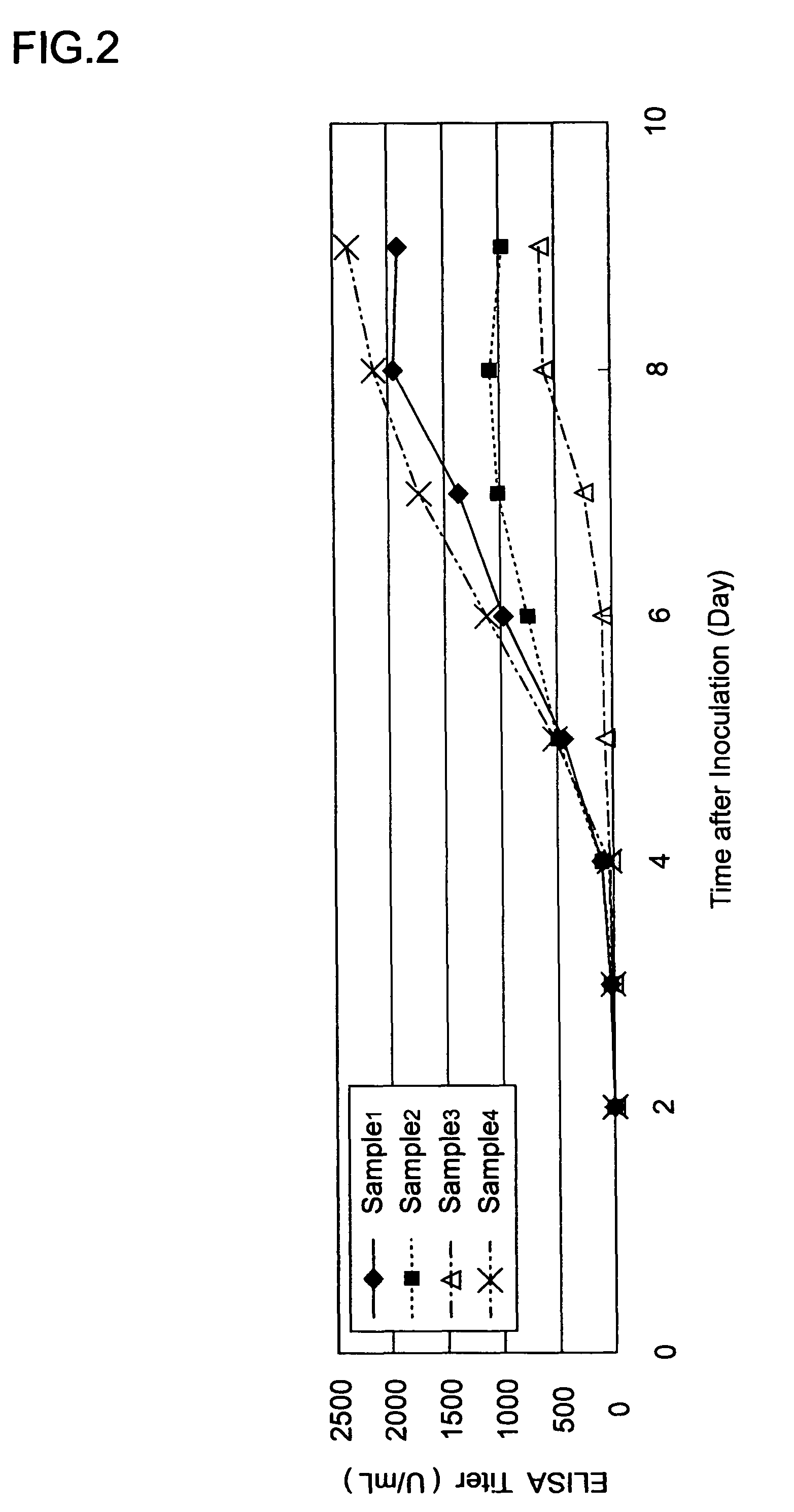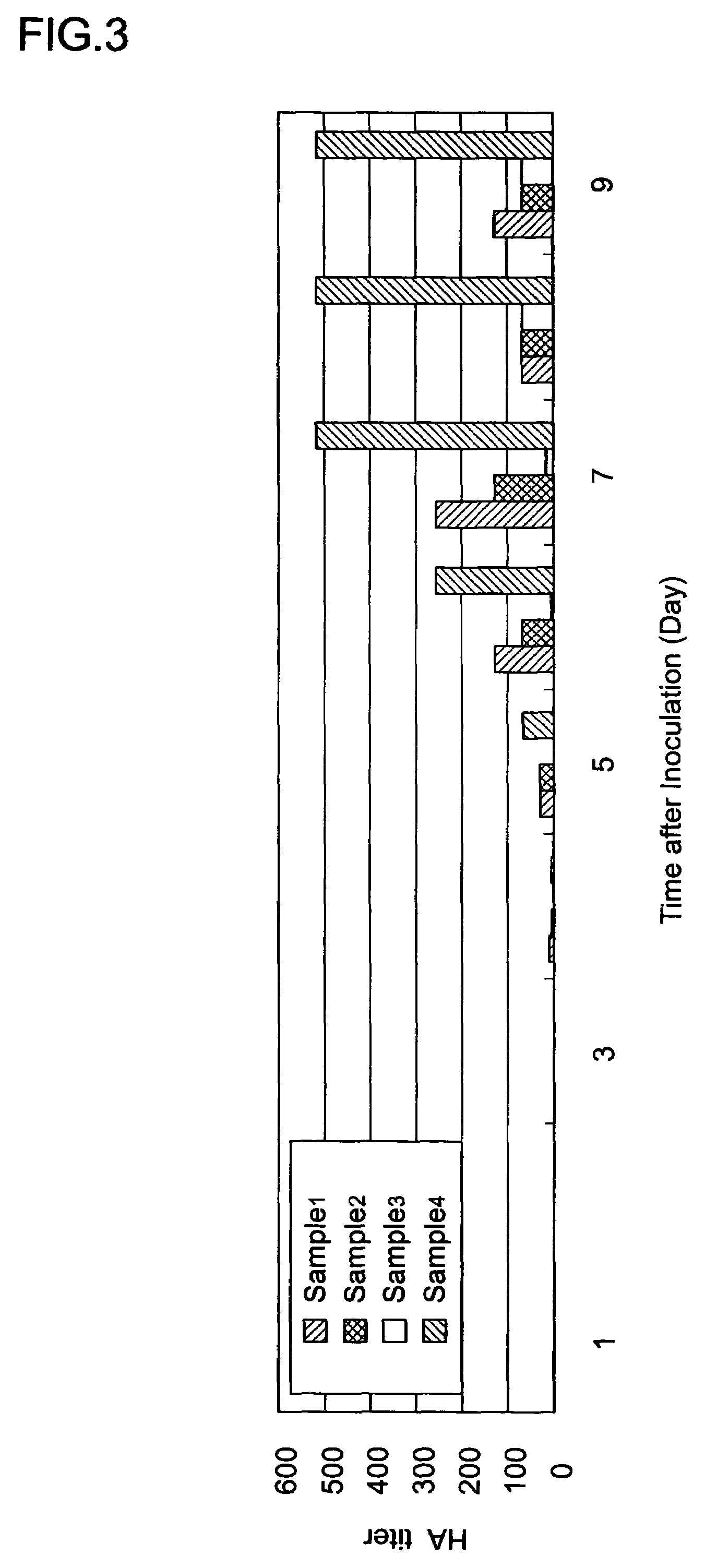Method of producing virus
a virus and virus technology, applied in the field of virus production, can solve the problems of inactivation treatment limitation, high risk, undeniable likelihood, etc., and achieve the effect of safe and efficient production
- Summary
- Abstract
- Description
- Claims
- Application Information
AI Technical Summary
Benefits of technology
Problems solved by technology
Method used
Image
Examples
example 1
Production of Japanese Encephalitis Virus Using Serum-Free Medium and ProNectin F-Bonded Nylon Beads
[0113](1) ProNectin F was diluted with phosphate buffer solution (PBS) so that the density of ProNectin F became 300 μg / ml, to produce ProNectin F solution. 100 ml of water-soluble carbodiimide solution (1-ethyl-3-(3-dimethylaminopropyl)carbodiimide hydrochloride (300 mM aqueous solution manufactured by Dozind) was added with 50 g of 12 nylon beads (particle diameter 150 to 250 μm, manufactured by Trial Corporation), and stirred by a stirrer for 2 hours. Then, 100 ml of phosphate buffer solution (pH=7.2) was added thereinto and the solution was removed by means of suction. This operation was performed 5 times (washing), and thereby carbodiimide bonded nylon beads (1) were obtained. Next, these carbodiimide bonded nylon beads (1) were soaked in 100 ml of ProNectin F solution, and stirred for 2 hours. Then, 100 ml of phosphate buffer solution (pH=7.2) was added thereinto, and the soluti...
example 2
Production of Influenza Virus Using Serum-Free Medium and ProNectin F-Bonded Nylon Beads
[0126]A sample 8 comprising a VP-SFM medium and ProNectin F-bonded nylon beads was put into a spinner flask (F7689 manufactured by Techne Incorporated).
[0127]Next, the Vero (S) for cell dissemination were disseminated in the spinner flask containing the sample 8 so that the cell density became 2×105 cells / mL, so as to make the operation volume (M)100 mL. Then, the culture solution containing the cells, the medium, and the microcarrier was stirred at 35 rpm so as to adhere the cells to the microcarrier. Then, the cells were cultured using a magnetic stirrer (MODEL1104M manufactured by Wakenyaku Co. Ltd.) at a stirring rotational speed of 35 rpm in a thermostatic chamber at 37° C. for 24 days.
[0128]The subculture of the cells was performed every 8 days. From the 3rd day of the cell dissemination, 50 volume % of medium was exchanged every day. The cells were dispersed by rProtease that had been used...
example 3
Production of Influenza Virus Using Serum-Free Medium and ProNectin F2-Bonded Nylon Beads
[0130]The virus was produced in the same manner as that of Example 2, except that ProNectin F2-bonded nylon beads were used instead of the ProNectin F-bonded nylon beads that have been described in Example 2 {proNectin F2 bonding amount: 0.3 μg / cm2, the beads were produced in the same manner as that of the ProNectin F-bonded nylon beads, except that ProNectin F2 was used instead of ProNectin F.) The HA value obtained in the same matter as that of Example 2 was 128 times.
PUM
| Property | Measurement | Unit |
|---|---|---|
| specific gravity | aaaaa | aaaaa |
| specific gravity | aaaaa | aaaaa |
| surface area | aaaaa | aaaaa |
Abstract
Description
Claims
Application Information
 Login to View More
Login to View More - R&D
- Intellectual Property
- Life Sciences
- Materials
- Tech Scout
- Unparalleled Data Quality
- Higher Quality Content
- 60% Fewer Hallucinations
Browse by: Latest US Patents, China's latest patents, Technical Efficacy Thesaurus, Application Domain, Technology Topic, Popular Technical Reports.
© 2025 PatSnap. All rights reserved.Legal|Privacy policy|Modern Slavery Act Transparency Statement|Sitemap|About US| Contact US: help@patsnap.com



